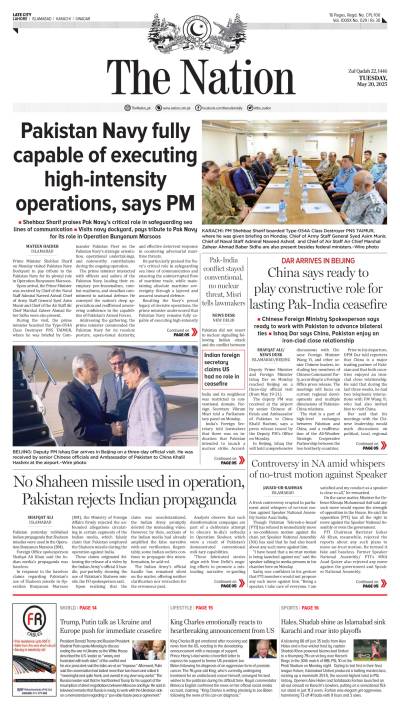Writing in this column a few weeks back, this scribe tried to expose fabrications about the feasibility of Kalabagh Dam and the attempts made by blackmailers to cover up these lies. By quoting from the views and technical reports of national and international experts on dam construction, we had shown that the opinion expressed by opponents of the dam was based on their political outlook and not on the technical feasibility of the project.
For instance, the theorists from Khyber Pakhtunkhwa (KPK) were mostly motivated by their desire to control the huge power station proposed at Kalabagh and, thereby, earn the power royalty yielded by the dam. They made no secret of the matter by letting it be known that if KPK is denied the power station by the majority province, then the province will deny the very dam to the nation.
The majority province, it was explained, was doing nothing to control the power station. It was the River Indus whose direction of flow would render the placement of the power station in KPK territory an impossible task. Likewise, the opposition from the Sindh government was also misplaced and based on pure speculation. For instance, who could predict, as Sindhis say, that the water of Indus will eventually be stolen by Punjab and render Sindh into a desert?
The most intriguing part about the campaign against Kalabagh Dam has been to publicise that a dam much bigger than Kalabagh could be built on Indus at a site called Diamer Bhasha located 197 miles upstream on Tarbela. The dam was billed as a monumental structure, largest of its kind, and capable of resolving all the existing energy and irrigation problems. This fact cannot be ignored. Neither can be ignored the other vital factors, such as building cost, very difficult access to the site from Punjab, no availability of foodstuff in the vicinity of the dam area, as well as the non-availability of trained personnel in the northern areas where the dam will be located.
As regards, the building cost of the proposed Bhasha Dam it is estimated to be $14 billion. Compare it with $352 million cost of Mangla Dam and about $800 million of Tarbela Dam. The latter does not include the cost incurred by the continuing repair work in the tunnel area.
The extremely difficult access has to be a 200-mile long road that, considering the rocky terrain around the dam sites, will cost substantial additional funds. Transporting heavy equipment from some point on the national highway or the motorway to Bhasha would be a monumental job. One may recall that the shifting of equipment from Karachi to Mangla was mostly done via goods trains, which unloaded the equipment right at the heart of the Mangla site.
Yet, another costly item would be the setting of power transmission line from the source, Bhasha, to the national grid. The location of the dam makes it a rather difficult and expensive job because here the river cuts through rocks and poses a challenge to the digger.
The story of carrying water through irrigation channels is even more discouraging. Here we are confronting about 200 miles of hard rock that must be blasted for mile after mile. No amount of irrigation water can be transferred directly from the Bhasha reservoir to irrigation canals like it is done at the Right Bank Canal feeding DIK and neighbouring area.
Thus, studied from various angles, the cost of the main dam and the affiliated works is likely to prove formidable. Add to this the time factor. Building Bhasha will take at least eight to ten years. The dam, therefore, will make no contribution to alleviate the ongoing energy crisis. After talking to some highly qualified and experienced national and international construction engineers, including Mr Hussain Tariq, builder of the longest bridge on Indus near Mianwali, Mr John Eiller, Chief Engineer of Mangla Dam Contractors, and Mr Barkat Luna, Chairman National Development Council, we conclude that unlike Mangla, nobody knows for sure how much time will be required to build the Bhasha Dam. In case of Mangla, it was declared at the onset that as desired by the Pakistan government the contractors would try their best to build the multipurpose dam a year ahead of the schedule. Thus, the project was completed in five instead of six years.
Bhasha is anybody’s guess, but nobody commits the timeframe.
The other factor that makes Kalabagh a proposition better than Bhasha is the volume of annual river flow. It should put the supporters of Bhasha to shame, as we are told that the river flow is much less in Bhasha than Kalabagh. The flow travelling downward in case of Kalabagh is 90 million acre feet, while in case of Bhasha it is only 50 million acre feet. The availability of water for irrigation and power generation is related to the total annual flow of the stream.
Other negative features of the Bhasha happen to be the construction and maintenance of high voltage transmission lines. These will run from the generation point to the load centre. The cost of the undertaking will be excessively high.
Another discouraging feature of the Bhasha project concerns the height of the proposed dam and its comparison with Kalabagh. The Bhasha Dam with concrete embankment if built would be 893 feet high, while Kalabagh with earth-filled embankment would be only 260 feet above the riverbed. The cost of building a concrete dam as high as Bhasha will cost many times more than Kalabagh Dam. A poor country like Pakistan cannot afford to enjoy the luxury of building dams as expensive as Bhasha, particularly when cheaper options are available.
We would like to conclude with the observation that the staggering cost of building Bhasha does not yield the proportional results. Its estimated cost of $14 billion creates a live storage of 6.4 million acre feet, which is only slightly higher than Kalabagh with live storage of 6.1 million acre feet. The estimated cost of Kalabagh Dam is $6.5 billion - two times less than Bhasha. Hence, only people with questionable intelligence would build Bhasha when Kalabagh is around.
The writer is a freelance columnist.
Tuesday, May 20, 2025
Diamer-Bhasha Dam: cover up for lies
Pakistan, India DGMOs agree on gradual troop pullback by May 30
2:59 PM | May 20, 2025
Govt declares public holiday on May 28 to mark Youm-e-Takbeer
2:40 PM | May 20, 2025
Pakistan plans to secure $4.9bn in commercial loans for FY2025-26
2:33 PM | May 20, 2025
US cancels another $60M in grants to Harvard University
1:14 PM | May 20, 2025
Excavation resumes at Mohenjo Daro after 18 years, UNESCO leads effort
1:12 PM | May 20, 2025
-
Lahore emerges among safest global cities in Numbeo 2025 index
-
Lahore emerges among safest global cities in Numbeo 2025 index
-
India’s suspension of Indus Water Treaty legally baseless
-
Seventh polio case reported in Pakistan amid nationwide vaccination drive
-
Pakistan reports sixth polio case of 2025
-
PTA begins issuing VPN licences to regulate usage
The Wider War
May 20, 2025
Margalla on Fire
May 20, 2025
Defeated and Depressed
May 20, 2025
Regional Reset
May 19, 2025
Peak Potential
May 19, 2025
Worse than Anarchy
May 20, 2025
Salute to our Air Force
May 20, 2025
An Unbreakable Wall
May 20, 2025
Profiteering Milk
May 20, 2025
Rewriting the Rules
May 20, 2025
ePaper - Nawaiwaqt
Nawaiwaqt Group | Copyright © 2025





